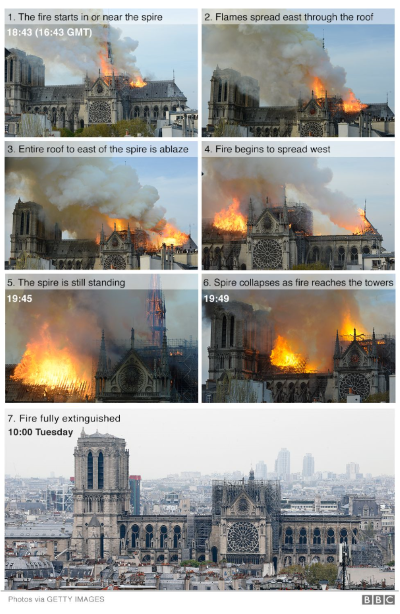 The IHBC asked former Membership Secretary Paul Butler for a take on some critical and historical issues around the modern response to Notre Dame, in the hope they will inform topical discussions across our membership as we approach the IHBC’s 2019 Nottingham School – ‘Heritage risk and resilience’ in July.
The IHBC asked former Membership Secretary Paul Butler for a take on some critical and historical issues around the modern response to Notre Dame, in the hope they will inform topical discussions across our membership as we approach the IHBC’s 2019 Nottingham School – ‘Heritage risk and resilience’ in July.
Comments, thoughts, offers and suggestions should be sent to our new national office support officer, Michael Netter, at services@ihbc.org.uk
image: BBC website
Paul Butler writes:
It looks as if there will be an international competition to redesign the spire at Notre Dame:
Read the article in the Guardian
The Prime Minister Édouard Philippe said, ‘the result of the competition would be to give the 850-year-old building ‘a spire suited to the techniques and challenges of our time’.
Our architects are setting out their stalls:
- Norman Foster: ‘In every case [of major repair/rebuilding], the replacement used the most advanced building technology of the age – it never replicated the original’
- Robert Adam: ‘They should do what they did at York [Minster, which suffered a similar fire in 1984] and put it back so that people wouldn’t actually notice.’
- The present Surveyor to the Fabric at Westminster Abbey, Ptolemy Dean: ‘To me, it’s a slightly deeper question than putting something in and making it a statement of modern thought; I think it’s also tied to the functionality of that roof void. You could make something rather amazing in there that explains the whole story of the fire and reveals something about the Gothic vaults’.
This last is perhaps slightly analogous (though Ptolemy Dean didn’t say so!) to the new Jubilee gallery in the east triforium at Westminster Abbey – for background see the IHBC NewsBlogs.
In fact, however, our Notre Dame is Westminster Abbey: an extraordinary Gothic building which symbolises so much of British life and which took centuries to reach its current built form. And at various times in its life there have been major debates about how it could be completed or changed.
One of the most intense periods of debate was in the early 18th century and the key personnel were Wren and Hawksmoor. Wren had ambitious plans for a new tower and spire. Despite his classical inclinations, he wanted his designs ‘to agree with the original scheme of the old Architect, without any modern Mixtures to shew my own Inventions’ (quoted in Gordon Higgot, ‘Sir Christopher Wren’s failed project for a crossing tower and spire at Westminster Abbey, 1713 – 25’, The Burlington Magazine , Vol 161 January 2019, pp 44 – 57).
When Hawksmoor took over as Surveyor of the Fabric in 1723, Wren’s plans were abandoned, partly because they may well have been structurally unsound. What he did do however was to complete the west end of the abbey (unfinished at the time of the Dissolution of Monasteries). His solution: twin towers clearly based on medieval precedents but also clearly of their time. This was his last commission and arguably his ‘greatest single achievement as an architect’ (Higgott again).
May the same be said of whichever architect wins the commission for the new spire at Notre Dame.
For more background on ongoing reports see:

